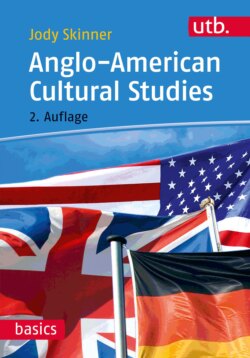Читать книгу Anglo-American Cultural Studies - Jody Skinner - Страница 94
На сайте Литреса книга снята с продажи.
Describe the importance of the Acts of UnionActs of Union up to 1801
Оглавлениеunion of EnglandEngland and ScotlandScotlandThe very attentive reader might have noticed that the words “EnglandEngland” and “English” and “Britain” and “British” seem to be used almost interchangeably. But there are big differences, as we learned in our very first geography appetizer. We can trace one big historical difference back to the passing of the Act of Union in 1707, which united the Parliaments of the previously independent kingdoms of ScotlandScotland and England and created the new country of Great BritainGreat Britain. As we now know, England and Scotland had shared the same monarch since JamesJames created the Union of the CrownsUnion of the Crowns. Each monarch after James thus wore two crowns, one for Scotland and one for England. England and Scotland agreed to an Act of Union not so much out of sympathy for the poor monarchs having to wear two heavy crowns but more because of the practical need for England to safeguard itself from possible Jacobite attacks (no one could know that the Battle of CullodenCulloden would indeed be the very last failed attempt of the Catholic Stuarts to regain the crown) and Scotland’s need for economic assistance. England promised free trade, Scotland agreed to be ruled in future by Protestant Hanoverian monarchs. The Scots were allowed to keep their own church, their own school system, and their own legal system. Since AnneAnne I (the last of the Stuarts, younger sister of Queen Mary, who ruled England with William IIIWilliam III, as we’ve already heard) was the queen both before and after the Act of Union of 1707, she was thus the last Queen of England (and Scotland) and the first Queen of Great Britain. But perhaps because the phrase “Queen of England” or “King of England” is so much easier to say, it’s been used ever since although actually between 1707 and 1801 the correct term would have been “Queen or King of Great Britain.”
union of Britain and IrelandIreland“Queen of EnglandEngland” certainly is much easier to say than “Queen of the United KingdomUnited Kingdom of Great BritainGreat Britain and IrelandIreland,” [70]which became the proper title in 1801 in another Act of Union when Ireland was forcibly joined to Great Britain against the will of many Irish CatholicsCatholics. The unification of the two main islands of the British IslesBritish Isles provided the largest free-trade area in Europe with no internal borders or local tariffs and contributed to the spread of the Industrial RevolutionIndustrial Revolution.
early forced union of EnglandEngland and WalesWalesBut we also need to mention the first Act of Union, the origins of which go back to the time of Edward IEdward I and his son, the first Prince of WalesPrince of Wales. It wasn’t until King Henry VIIIHenry VIII, with whom we began the previous section, that EnglandEngland and WalesWales were officially united by the Act of Union of 1536 or rather Wales was (forcibly) united with England. You can still see the lack of importance of Wales in the Union JackUnion Jack flag. While both ScotlandScotland and IrelandIreland are represented through crosses and colors, the WelshWelsh dragonWelsh dragon simply doesn’t appear. It’s doubtful if the Welsh took comfort in the fact that the House of Tudor was of Welsh origin. After all these dates and acts and forcible unions, let’s finally end this section on a positive note. After so much bloodshed based on religion, in 1829 – just one more date for now – the Catholic Emancipation ActCatholic Emancipation Act – just one more act – was passed.
